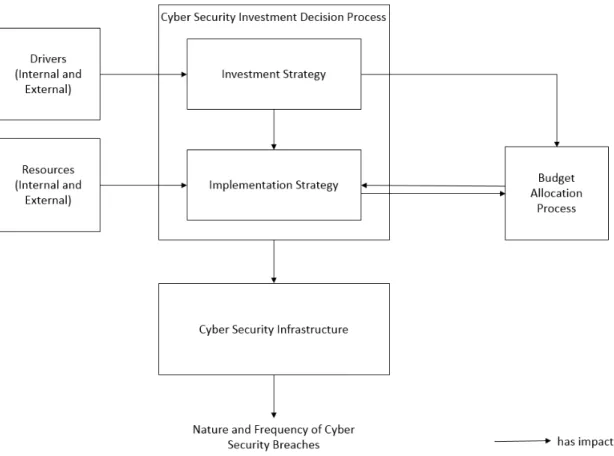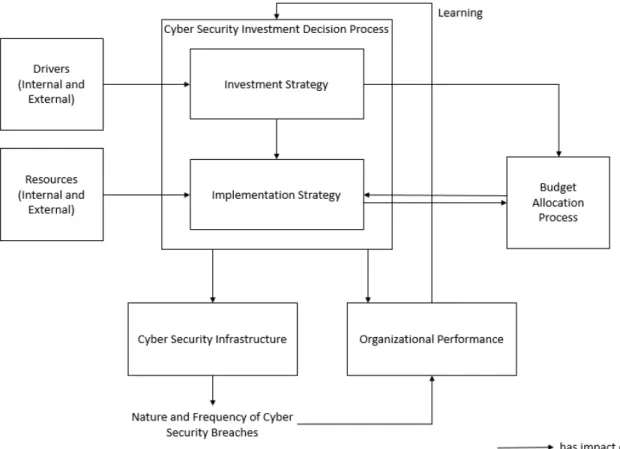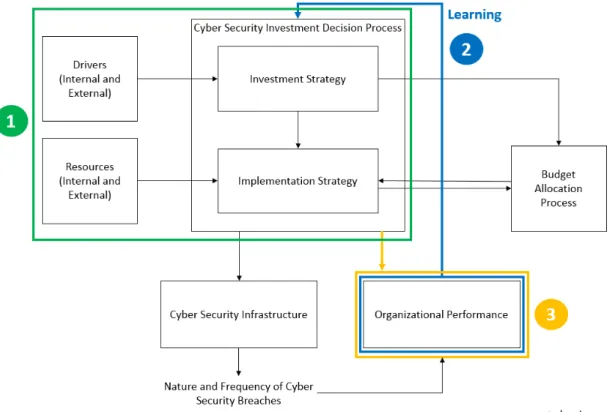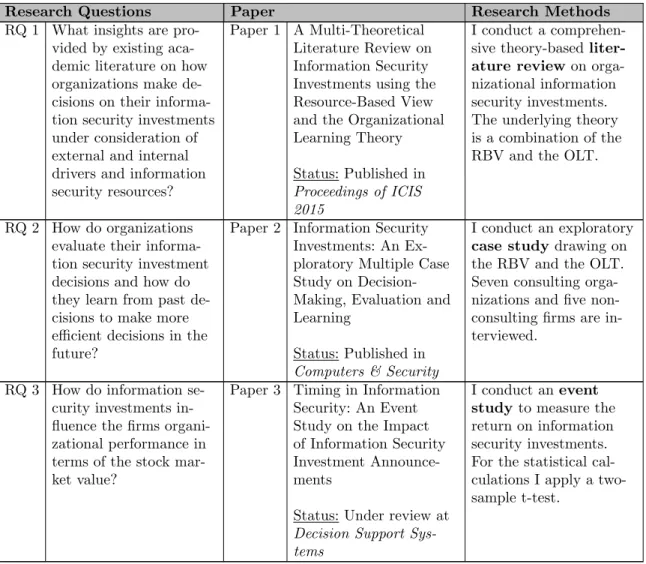Planning and Evaluation of Information Security Investments
Dissertation zur Erlangung des Grades eines Doktors der Wirtschaftswissenschaft
eingereicht an der Fakultät für Wirtschaftswissenschaften der Universität Regensburg
vorgelegt von: Eva Szubartowicz
Berichterstatter: Prof. Dr. Guido Schryen, Prof. Dr. Günther Pernul
Tag der Disputation: 26. Juli 2018
Faculty of Business, Economics, and Management Information Systems Department of Management Information Systems
Dissertation
Planning and Evaluation of Information Security Investments
submitted by Eva Szubartowicz M.Sc.
to
the Faculty of Business, Economics, and Management Information Systems
of the University of Regensburg for the Degree of
Doctor rerum politicarum in
Management Information Systems
Supervisors:
Prof. Dr. Guido Schryen Prof. Dr. G¨ unther Pernul
Regensburg, April 13, 2018
This dissertation is submitted for the degree of Doctor rerum politicarum at the University of Regensburg. The research described herein was conducted under the supervision of Prof. Dr. Guido Schryen, between August 2014 and December 2017.
This research was supported by the Bavarian State Ministry for Education, Science and the Arts as part of the FORSEC research association (https://www.bayforsec.de).
I would like to thank Prof. Dr. Guido Schryen for his valuable support and enthusiasm, my second supervisor Prof. Dr. G¨ unther Pernul, who also provided advice and feedback and my colleagues Mr.
Gerhard Rauchecker, Mr. Gerit Wagner and Mr. Emrah Yasasin each of whom has provided patient help and friendship throughout the research process.
Finally, I would like to take this opportunity to express my gratitude to my family for their love, encouragement and support throughout my entire course of studies.
Regensburg, April 13, 2018 Eva Szubartowicz
Part I Dissertation Outline
1 Introduction . . . . 3
1.1 Motivation . . . . 3
1.2 A Theoretical Perspective on Planning and Evaluation of Information Security Investments . . . . 8
1.2.1 The Research Framework . . . . 8
1.2.2 Research on Information Security Investments . . . 13
1.2.3 Research Questions . . . 20
1.2.4 Research Methods . . . 22
1.2.5 Contributions . . . 23
Part II Research Papers 2 Paper 1: A Multi-Theoretical Literature Review on Information Security Investments using the Resource-Based View and the Organizational Learning Theory . . . 29
3 Paper 2: Information Security Investments: An Exploratory Multiple Case Study on Decision-Making, Evaluation and Learning . . . 31
4 Paper 3: Timing in Information Security: An Event Study on the Impact of Information Security Investment Announcements . . . 33
5 List of Further Research Papers . . . 35
Part III Discussion 6 Discussion . . . 39
6.1 Summary . . . 39
6.2 Limitations . . . 40
6.3 Repercussions on the Research Questions and Implications for Academic and Practice 41 6.3.1 Research Question 1 . . . 42
6.3.2 Research Question 2 . . . 43
6.3.3 Research Question 3 . . . 44
Part IV Bibliography
References . . . VII
Dissertation Outline
Introduction
”Today information security is shifting from what is technically possible to what is eco- nomically efficient.” (Su, 2006, p. 4)
This thesis provides a theory-based understanding of information security investments within organizations concentrating on organizational planning and evaluation of information security in- vestments. The underlying framework is the Cyber Security Investment Framework of Rowe and Gallaher (2006). This work is structured as follows: In the remaining of Part I, the dissertation is motivated and the theory to frame this research is described in detail. Subsequently, in Part II, the publications which comprise this thesis are presented. Finally, in Part III, the findings of this dissertation are discussed.
1.1 Motivation
As successful organizations nowadays rely on information technology for every aspect of their busi- ness (Kankanhalli et al., 2003), information technology has become of crucial importance for them (Ernest Chang and Ho, 2006). With cyber security threats taking on new forms and methods, the need to secure firm’s systems, data and processes against misuse and attacks is of vital importance (Ernest Chang and Ho, 2006). Successful attacks can result in the disruption of production and processes or data theft, which cause economic damage, including losses in productivity and revenue (Bandyopadhyay et al., 2009). Besides actual and potential financial losses, other negative conse- quences of information security incidents include negative publicity, competitive disadvantage, and even reduced organizational viability (Kankanhalli et al., 2003). According to Forbes, worldwide costs of data breaches will reach $2.1 trillion globally by 2019, increasing to almost four times the estimated cost of breaches in 2015 (Forbes, Inc., 2016). These figures indicate the necessity of information security
1to protect firms’ business operations against internal and external threats (Anderson and Choobineh, 2008; Hall et al., 2011). The prevention of such threats causing security
1



